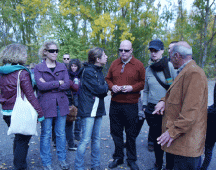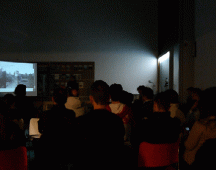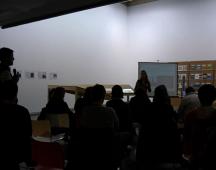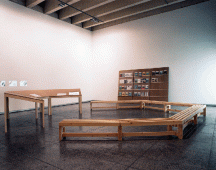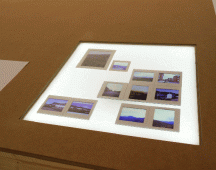Maqueta
- Castillete. Retablo Minero
The installation consist on a model of the Sabero Valey and a sound intervention. The sound starts when the viewer switchs on it. The model refers to the turistic devices used in the interpretation centers. Nowadays a large number of old industrial villages tried to reconvert themselves into touristic resorts.
This model shows all the industry traces in the landscape: the open air mines, the dumps, the miner´s houses, the industry´s buildings.


The color, black, refers to the coal, present also in the reports of the inhabitants of the village and so important in the construction of its landscape. This is the sound that forms part of the installation:
(english translation)
It’s all below. This is how I knew it when I was born, exactly like that. That’s Peñacorada, that high crag where you get the aeroplane rhythm, that’s Peñacorada. There are some houses, if you noticed, some blocks of flats they did for the workers, to the right, and beneath those, and this is a fact, right, there’s a thirty-metre coal seam, beneath the cement, there was, where the Olleros church is, all that under there is coal. Well, it’s obvious, when you see the edge of the road, which we still call the company road because before only lorries and miners went down it, you see the colour of the earth.
Were you on the flat bit? All that’s coal. Here were the maquis, too, they knocked around the mountains, like those in El Bierzo, and Calixto was here and… I dunno, there were ten or so of ’em: El Calixto, El Pistolas, El Falangista, the two Químicos, that other one… Ramirón…
Not many people know this, ’cos here there’re a lot of people from my time but who didn’t have ancestors here… I started work when Asturias surrendered. After Asturias surrendered I was six years in jail and then I went to ask Corrales for work and he said, There’s no coal for Reds; no work. And I said, Don’t worry, old chap, if I go to Hulleras de Sabero, no sooner do I arrive then I’ll get work, because there were some Asturian overseers here and they treated us people who’d been in prison quite well.
The whole relief shift went down at 8.30 and came up at 3.30 and the pit pony men, the one who wanted to earn an extra peseta or two because, if not, from a day’s graft like those… we were earning, I dunno, 9 or 10 pesetas, meaning that we were living… I hardly knew my kids.
Tt was the same everywhere then: from the mine alone nothing and from farming alone nothing either. I’m talking about here in the valley, right. I’m not talking about anything else. ’Cos they were coming from as far away as Valdoré to work on the mountain, so those fellows, when they arrived at work, what an appetite for work they had!!!
You had to bring a lot of school desks up and down and on top of that we had cold water. At seven in the morning washing everything in cold water wasn’t a load of fun… there weren’t any gloves, either.As it happens they were all young lads, as was my case, the materials involved were really bad then. I remember having a girlfriend and them coming to get me from the cinema in Sahelices because the lighting in the hut was failing, a stupid little thing, you can laugh about it, but that’s how it was.
And walking there at seven of a morning, with me coming out my house ’cos I was also living in the final houses there on the way out to La Herrera, from there I ran into some right snowfalls and all. In all the village there weren’t more than four lamps under the eaves and the light didn’t stretch as far as the ground and you got to Olleros and what you saw was light bulbs in the Sotillos pit, that was Hulleras, it was no longer the town hall. Being as it was the pit which was working normal, there were a lot of people, ’cos there was always a path. But from there on up, blimey!
The young people of today hear what people lived through in the civil war and they don’t give a monkey’s.
Because this company was keeping a load of families, eh! It was a dangerous mine due to the firedamp, which is the wind that smells bad from what the coal gives off, for that reason they took lamps. Another thing is the safety the company was proposing.And afterwards there was no longer silicosis, plus they obliged you to wear a mask.
Here the good thing we always had was good management.
Right, let’s start… we were still having a bad time of it then. Afterwards, the agreements between bosses and workers started up and things started being different.
In Colominas they were houses with two rooms, three, four, there were very big families and I was a little girl when they began to make them and there was a bathroom, a good shower, shower with toilet and all that, but those in La Herrara had no more than a toilet and washbasin. They were houses with three rooms, small but they were fine, a bathroom, a toilet and the kitchen. The kitchen was big, that was it.
And the houses were detached.
And where I was we had nothing, so I was landlady in the big house.
You had to be married, because if they gave it to the single men, madre mía!!! But you had to get married and then you got it.
When my father died they took the house away from my mother, that’s how it was.
School… they were in the houses in Colominas: the fourth year, the fifth year… each house was a year. And in Sabero there was another one. Afterwards all those houses got sold.
There was everything here. Sahelices got to have a thousand inhabitants. I remember in the late ’50s or 1960 there was a load of people here and it was when the emigration started to France and Germany and this remained half empty, only those of us who were from here stayed, the other people, they all went off, so then they had to go and look for people, I dunno, in Galicia, I dunno in what places, for people to come and work in the mines because there weren’t any.
What I don’t remember is what year it was, I don’t rightly remember the year, round about ’78, ’79, ’80 other nationalities began coming, Moroccans, as I was telling you, Pakistanis. It was as a result of the crisis of ’73, ’74, the oil crisis, the world crisis, they sent us to earth and us, we came here… trying to earn a crust.
And there was no room for people, not even standing up. Well, they were living in cubby-holes, in cubby-holes people were living.
And it was like that then, there was the lodging, you had a bed, food and everything.
Normally when you were single, like, then you went there.
There was where there was all the ruckus, because you found all kinds of houses and the best of each sort, as I put it. And then a few of us were looking not for boarding houses, but private houses. There were private house that took you in, you paid them by the month and they washed your clothes and you had a bed, food and everything.
One problem, which isn’t a problem, is that you have to learn very fast in the country that you go to if it isn’t your own.
But it’s a village that accepted people from outside, there wasn’t racism or anything, you all got on, what happens is the Andalusians are very religious, for example, but in their own way, with other customs. There were Basques. I reckon where we were living in La Herrera, if there were twenty Andalusians, there were eighty Basques. Later on, Moroccans, Portuguese, Cape Verdeans, all sorts of people. Most were Portuguese, I think, quite a lot more came.
At the time it was more… neighbours used to give each other a hand more than now, for instance.
There was never a problem, what there was here was a lot of aggro between rival colleagues. In Olleros Sunday wasn’t Sunday unless there was a punch up. That’s right… because people got more drunk then than they do now.
And we had a bar here when the mine was working, this was another mine.
And we were living off those who were working, don’t you know?
Because then the engineer was the son of another engineer or of a capitalist or of a major wholesaler or of the master of the mines, like… there wasn’t a foreman, there was nothing of the class of miner and yet here after Sabero there were at least four [foremen].
And so what do you want to know?
And so it was… clear, I reckon the company invested a lot then, after was when the government came up with that stuff about subsidizing the coal industry, 10,500 pesetas per unmined ton.
Sabero was a modern mine, it was number two or three in Europe in terms of safety and work.
This mine was ultimately like a health resort.
They got out a lot of coal there, it’s a very big valley. First they closed that, afterwards they closed Sucesiva, afterwards La Herrera, and lastly Sotillos.
And then they prepare the disputes of always: whether it’s closing, whether it’s not. He says, And the money to be shared out? That’s the last thing that’s negotiated! All in agreement.
The first thing they do: the lists of what each person was due.
They’d kept eliminating people, the company, with early retirement for the older people. The people who were going to cause trouble, they kept giving early retirement to. Then a very young bunch remained, the one who’s been there longest then was maybe twenty years, between fifteen, twenty, twenty-something, and the majority, well, five years, between five and ten. To a person who’d been working five years in the company who is twenty-something years old, thirty, they offer five million pesetas at the time… they were offering you money and work in a year or two… and of course everybody grabbed it.
And so they do the voting, but the signing was already done. And they wanted the workers to carry the can. This is why there’re a lot of people nowadays who say the workers closed the company down.
I think that among us workers we have to have a richer mentality of saying that if you’re united you have more chance to get something, if you’re disunited, no. Why was it like that here? Don’t ask me.
And before those years people fought hard. According to what they tell us, and you talk to the old people, they say that people were working from dawn to dusk and all that, and at that time they fought for more controlled and improved shifts and it cost a lot of strikes, even, but then later when we got to the ’80s all that was practically built, it was a matter of maintaining it, but it’s just that we reached a point…
I see the young people more healthy nowadays,
I see the young people very healthy, but without a future.
The sixth level and the seventh hadn’t been mined yet, a little bit maybe, but next to nothing, there was a lot still there.
I was there when they began doing the entrance of the eighth level… and that’s the way it stayed.
But sure, they had to close this one or Santa Lucía, because they belonged to the same company, so they closed this.
And I dunno if we’ll have to go back again to coal because the coal-fired power stations do pollute, but they work out cheaper than those windmills.
A lot of people left for the Ponferrada area, for El Bierzo.
This is a valley that was always the main provider of the workforce…
What put food on the table—coal and ’nowt else.
Here, now, we live in a desert because this was highly populated when the mine was working, but now… there’ll be around 3,000 of us, I dunno if there’ll be that many.
What happens is that in summer a lot of people have bought houses for next to nothing… for a month’s wages
Practically every day a coach pulls up in Sabero… to see the museum… a summer village is what we’ve become
People come, see everything and leave, they don’t spend a thing.
What did you feel when it closed?
Well, relief.
Relief?
Relief.
On the one hand, relief
because the last few years that you were between today it’s closing, tomorrow it’s closing and all… it was very uncomfortable, working.
I never wanted to move from here.
translation MUSAC








